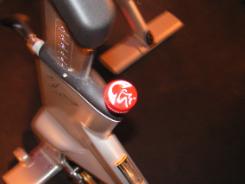In part 1 of this series on coaching resistance in cycling classes, I described a popular but ineffective coaching method that fails to account for the difference in abilities and fitness of riders or the differences in the wear and tear on bikes.
The second method of teaching resistance that instructors should avoid is to assign a 1–10 scale of resistance. This one is even worse (in my opinion) than assigning a number of turns—it’s very confusing, it’s subjective, and it’s not anchored to anything. While I’ve seen a few variations, the idea is that a resistance of 1 through 5 indicates a gear that resembles a “flat road” and that 6 through 10 would indicate a “climb.”
Below are four reasons why this method leads to nothing but confusion for riders. It’s even more confusing if you use a 1–10 scale for RPE that doesn’t always coincide with your terrain scale.
In part 3, I will give you a way to describe coaching resistance combined with cadence that should greatly help your riders’ understanding of what intensity you want them to ride.
[box]
For your review:
How to Coach Resistance in Your Indoor Cycling Class, Part 1
[/box]


Yes, I have a need for a poster, say 2’X 3′ on your RPE scale. I would like to post it on the wall in the studio where I teach indoor cycling.
Can you supply these? Your reply would be appreciated.
Jim McClain
Hi Jennifer, this is what i wrote in my book INDOOR CYCLING about coaching intensity. Hope you like it 🙂
(Sorry for the Danish/English translation)
The secret behind a good cycling class
Classes for beginners are always the hardest to instruct. You have to make the participant feel comfortable at the lesson. Many have some prejudice about indoor group cycling and thus some fear, they first have to overcome.
For some, working out is something new and some people never tried to really sweat before. It is your job as an instructor to give them the best possible experience so that they come again. If you instruct the class right, the majority will think good of it and you have helped them one step closer to their goal. If it went well, they will choose you as an instructor in the future.
So, what is it that makes a lesson good? Primarily, it involves giving the participants what each of them came for. This you can only do one way and that is by ‘individual group cycling’.
‘Individual group cycling’ covers getting each participant to only challenge his own limitations, this means that he follows the intensity and workout resistance that suits himself. If all participants follow the same intensity and have the same subjective perception of the workout, then it feels the same for all.
The way to do this is by having good cueing, when the intensity is being changed. A change of intensity without telling exactly how much, can seem misleading. If an instructor every 30th second cues more resistance on without telling how much, then the participants will quickly sit with different intensities and some may give up.
So, do not only tell that resistance is added, also tell how much and how the resistance feels on the legs. Do not only tell that the heart rate will increase, but also how much and how it should feel. Tell how much out of breath, how warm and how else it is supposed to feel. Thereby you keep all participants at the same intensity and the older lady can sit next to the young athlete both getting the same benefit of the class. Both leave the class with a good feeling and will return to your classes.
That is the secret behind a good cycling class!
Great article. We recently got new bikes at one of my facilities. In order to acquaint members with them, they wrote on a white board ‘Power = Resistance x cadence’ which was great and ‘Flat = Gear 1 – 8, hill = Gear 8 – 15′ and heavy hill = Gear 15+’ which wasn’t great. The first class that I had on the new bikes, a member approached me and said ‘Something must be wrong with me. My hill starts below gear 8’. I responded by saying that hills were simply imaginary terrain and that the gears were individual, corresponding uniquely to each rider. I coached the class based on cadence matching the music and perceived exertion, since they hadn’t had an FTP test. She seemed to understand that and left feeling better about herself.
thank you for sharing this story because it highlights why I this article was so important to write. I get so angry when I see instructors in the online forums talking about assigning a number for terrain. It makes people think there is something WRONG with them if they don’t fall into the ridiculous boxes they use to define a “flat” road and a “hill.”
Although I love the whole visualization aspect of climbing epic mountains (especially since I live in the mountains and climbing them is so spiritual for me), sometimes I think we do more harm than good by defining our efforts on an indoor bike as flats versus climbs. I know that Stages doesn’t really do that.